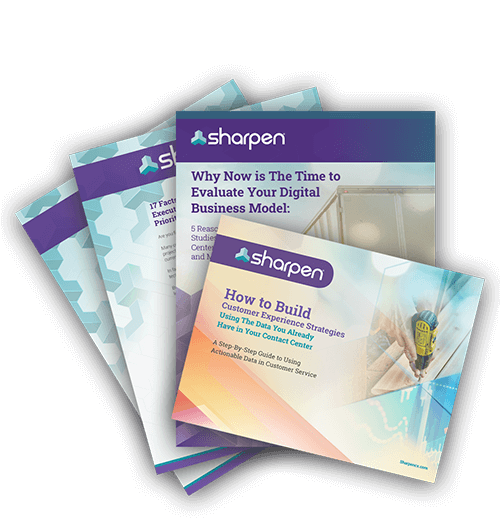
2 Guided Ways to Test Your IVR Experience so You Understand How it Impacts Your Entire Customer Journey
I can’t tell you the number of times I’ve heard my mom yell “TALK TO A HUMAN” or “HELP” after battling with an IVR that didn’t have crystal clear instructions. It happens. A lot. And I know I’m not the only witness to these episodes of battle of the bots.
Turns out, more than 80% of customers get immediately frustrated with your brand after interacting with your IVR. It’s tough to set your agents up for successful interactions when customer satisfaction plummets before they ever reach a live human.
IVRs are the customer service channel companies use the most, yet too often they don’t align with your customer’s expectations or the rest of their journey. I’m here to talk about how you can improve your IVR with better testing and how to address the common concerns customers have with your lovely auto-attendant.
McKinsey & Co found these 5 common issues with IVRs:
- A one-size-fits-all mentality where you funnel customers (whether new or old) down the same path
- Confusing navigation and language that fits internal processes over customer needs
- Lack of integration with other channels that connect the entire customer journey
- Slow updates and modifications
- Getting no input from customers on their satisfaction with the experience
Let’s tackle these top concerns and create a better experience for your customers. Here’s how.
Improving your customer’s IVR experience with testing
Traditional routing strategies and IVRs mirror that of your doctor’s office. A customer calls in, an IVR serves up a few options to punch through with DTMF tones, and the IVR sends them off to the right agent.
More advanced tech now uses voice detection to trigger certain pathways based on a customer’s answer to a question. Let’s say your customer gets a greeting that says “how can I help you today?” Rather than pressing a number, they respond with a phrase like, “reset my password” or “cancel my subscription.”
But how do these experiences play out for your customers? Do they like to punch through a simple menu? Or, do they like to give you specifics upfront? Do they appreciate when they can type in an account number and verify their history before reaching an agent? Or, would they prefer to dive straight into the conversation with a human?
[Read Next] How to build effective omnichannel routing strategies
This is where different testing comes into play. When I talk about IVR testing here, I’m talking more about experience testing. How can you map out different scenarios and understand the impact to your overall customer experience?
The right vendor partner (like Sharpen) will handle technical testing for you. So here, it’s important to think through your role in the IVR testing process. Think about specific questions to ask yourself, your agents, and your volunteers as you map out your inbound routes and how customers punch through (or talk through) your IVR. And, think through how to document any glitches you find, so you can fix them along the way.
Let’s dig in.
Experience Testing
When you test your IVR experience, you need to test it from two different perspectives: your agents’ viewpoint and your customers’ viewpoint.
What to test from a customer’s perspective
High-effort experiences scare off 96% of customers. Often, interacting with your IVR is the first service experience a customer has with your brand. Don’t make it tough on them from the get-go. As you think through your customer’s experience interacting with your IVR, keep their needs top of mind. One of the top grievances customers have with IVRs is that the menu options don’t match their needs.
“The wording and menu structures used in IVR systems often reflect the company’s internal terms and processes rather than the language and needs of customers.”
Confusing terms and unclear instructions cause hiccups in the customer journey.
Ask yourself these 6 questions to keep your customers top of mind as you test:
- Do my customers have the option to leave a voicemail or get placed in a callback queue?
- What do my customers hear while they’re on hold? Music? Important announcements? Silence and their own thoughts?
- Is there an escape route to a live agent? (Like pressing “0” to barge through)
- What happens when a customer calls after hours? Do they have a way to find help, or do they have to hang up and try again tomorrow?
- If my system uses voice recognition, does it account for common mispronunciations of words?
- Do my menu options play on repeat if a customer doesn’t select an option?
Turning inward isn’t the only way to test. As McKinsey & Company’s data shows, your company’s expectations sometimes don’t sync up perfectly with your customers’. So, the best testing strategies use input from customers to make the experience even better. Find a few friendly customers willing to help, and track satisfaction with their experience.
Here are 13 questions to ask customers who help with IVR testing:
- What option did you press when you reached out and what were you hoping to accomplish?
- Were you offered a callback after 1 minute on hold?
- Did you accept the callback after it was offered?
- Which agent did you talk to? (This helps supervisors and managers know the call was routed correctly.)
- Was the audio clear throughout the entire IVR recording? (Ask customers to note the timestamps of any issues they have.)
- Do the menu options make sense?
- Do they cover common questions you’ve had in your customer journey?
- Did the hold music loop during your entire wait time, or did cut out, leaving you waiting in (awkward) silence saying “Hello, you there?” repeatedly?
- Did you have the option to leave a voicemail?
- Were you prompted to answer security questions to verify account numbers or sensitive information?
- Did the IVR repeat a prompt if you didn’t select an option? How long did the system take to repeat the prompt? (Was it more like 30 seconds of silence or one minute?)
- What cell phone carrier do you have? (So you can compare experiences from AT&T, Verizon, Sprint, and the like)
- What location did you call from? (Did your customers in big cities have the same experience as those living in rural areas?)
Pro tip: As you test, build internal processes for collecting info and presenting questions to your vendor, so you can ensure you’re self-serving and only escalating when you need help. This will help you train and test more efficiently and get the help you need in a measured and organized way. Your vendor partner can help you more effectively when they know the exact problems you’re facing with your IVR and what you’ve already tried to fix them after testing.
[Learn More] Strategically support your customers with a vendor that supports you
What to test from an agent’s perspective
Once a customer calls in and punches through the IVR, how do the interactions get funneled to your agents’ queues?
Here, you’ll want to properly test all the inbound routes you set up. Don’t fret – your vendor (hey, over here!) will lead the charge on this. But knowledge is power. So educate yourself on common questions first, then have the needed conversations with your vendor partner.
14 checks to run during agent experience and routing testing:
- If a customer requested a callback, does the agent get notified?
- If a customer leaves a voicemail, does it forward on to the agent?
- Do the right menu options correlate to the right inbound routes and agent queues? (If a customer presses one to talk to billing, do they actually reach an agent who handles billing?)
- Is there a delay in interactions coming into the queue after a customer punches through the IVR?
- Do agents have two-way audio, or is someone left sitting in silence?
- Do calls drop after a customer reaches an agent, or do they successfully transition from IVR to the live interaction?
- Is the right on-hold music playing?
- Is the call being recorded?
- Does the call recording automatically forward to a specific email address?
- Do high-priority customers get weighted appropriately and sent to the right queues?
- Do you have the right agent skills attached to each route?
- What happens if someone sends a text through this inbound route instead of calling?
- Do you have the right time controls set up? (So if your customer service hours are 8-5, you don’t send a customer into a never-ending queue with hold music on loop at midnight).
- Does the call route to the right group when a specific case number is mentioned and verified in your CRM?
Then, move on to your final checks and common issues to troubleshoot.
Have your agents completed their necessary training ahead of go-live? Ask 100% of agents to complete an agent readiness assessment at least a week ahead of go-live, so you can troubleshoot any issues that pop up and have ample time to make sure your agents are confident with how to handle the system. The assessment can be as simple as having agents log into their queue and handle a simulated interaction.
Once you’ve run through these IVR tests, document what you learned and bring any glaring issues to your vendor. And, create a system for running these checks again on a regular basis. As your customer journey evolves, how you communicate with customers should, too.
[Read Now] It’s never too late to build your digital customer experience. Start today.


